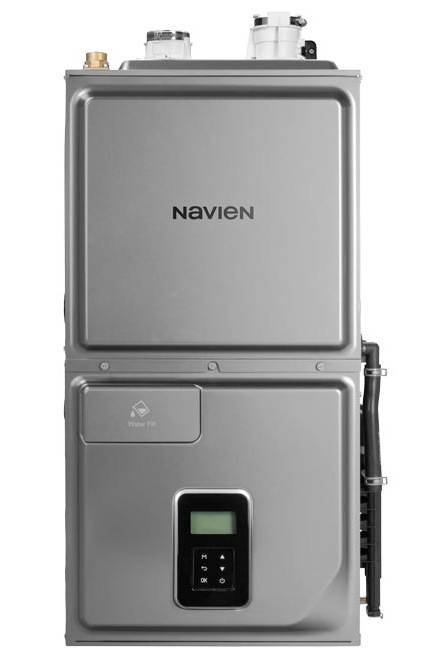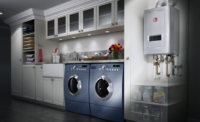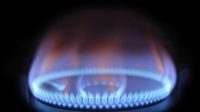In late September Navien held a virtual product launch event to announce three new products, one of which is the company’s first-ever HVAC product — the NPF Hydro-furnace. To hear more about the product launch and Naviens plans for the HVAC market, Supply House Times chatted with Product Management Director David Hoskyn after the event.

Available in Upflow and Horizontal configurations, the NPF comes in two sizes of 60,000 BTU/h and 100,000 BTU/h that both boast 97.0% AFUE and meet the stringent requirements of SCAQMD rule 1111 for Ultra-Low NOx performance.
SHT: Tell us about the decision to branch into the HVAC market. Why is now the right time?
DH: We have heard that question many times during the development and launch of the Hydro-furnace, but I want to point out that indirectly we have been in HVAC for a while. We have seen our boilers or water heaters feeding air handling units with hydronics coils for many years. The NPF now combines those to give us a true HVAC product in the market. We also understand that the entire industry is evolving and changing, but we feel there is still a place for this product.
SHT: What is the Hydro-Furnace, and how does it work exactly?
DH: The Hydro-furnace combines the proven technology of our stainless-steel condensing heat exchanger with a hydronic heat exchanger coil that is placed in the conditioned air stream. In heating mode, water is heated in the combustion heat exchanger and pumped up through the hydronic coil. The hot water flowing through the coil then heats the air stream. One major advantage of this process is our ability to vary the combustion capacity of the unit from 15-100%, which combined with the ECM variable speed blower provides a very consistent room temperature throughout the varying demands of the heating season. This design also allows us to operate the unit at a much lower plenum temperature, and control the unit based on either the supply air temperature or return air temperature.
Available in Upflow and Horizontal configurations, the NPF comes in two sizes of 60,000 BTU/h and 100,000 BTU/h that both boast 97.0% AFUE and meet the stringent requirements of SCAQMD rule 1111 for Ultra-Low NOx performance.
SHT: How much research and development went into this product? Have you considered the specific needs and preferences of HVAC contractors in your product design?
DH: As with all our products, there was extensive R&D done on the Hydro-furnace, along with field trials in existing home applications. The benefit of this product is that it adapts much of the technology from our other boilers, combining many proven off the shelf components.
In terms of the needs and preferences of the HVAC contractors, we tried to address those through industry standard cabinet widths to adapt to coils, common furnace heights to help with replacement work, and fully capable airflows up to 1.0” static. In addition, the control panel on the NPF provides a clear setup wizard to assist with set up, along with full menu functionality to adjust heating, cooling, and airflow. The NPF also includes the option for either variable air control, or constant air volume. All of this is done using any single stage or two stage thermostat and does not require the addition of a special wall control. And to help support the contractor, the NPF will carry a strong warranty which will include 1 year labor coverage for all products.
SHT: How will Navien address environmental concerns and energy efficiency requirements in its HVAC products?
DH: The name Navien is made up from the words “Navigating Energy and Environment” and comes from our desire to make products that are environmentally responsible and lower energy usage. From our launch of the first condensing tankless water heater in North America back in 2008, to our condensing combi and boiler products, our focus is on high efficiency products to lower energy use and emissions. The NPF continues that with a 97.0% AFUE rating, and controls that operate the unit only at the capacity required to satisfy the load. Combined with Ultra-Low NOx on all the units, not just market specific ones, we help lower the GHG emissions throughout the US and Canada.
SHT: What are the future plans for Navien and the HVAC market? Are there more new products on the pipeline?
DH: We are always looking at products that we can add to our lineup, but only if it adds value to the market. If we can introduce a product that does not currently exist, or improve on one that already does, then we certainly will consider it. Since Navien is part of a global company, we are also looking at other markets such as Europe and Asia to follow developments there. I am confident that the NPF will not be the last new product that we introduce for North America.
SHT: What are the top customer — contractor and end user — needs in the tankless market in 2023?
DH: As we know the tankless industry is going through some changes right now. Issues such as efficiency regulations, electrification, and restrictions on greenhouse gas emissions all have been in the news lately. The trades are also still trying to bring more people to the workforce to help install and service whatever products are out there. Finally the end users are still not sure what many of these changes mean for them in terms of all gas appliances, not just water heaters. But for tankless in general I don’t think the needs have changed that much – the contractor wants you to have a good product that is easy to install and service, and provide training and technical support to help them be efficient at their job. They also want to know that you are a reliable source for information about what is going on in the industry, since most are too busy to keep up with the changes. As for the end user – they want hot water without having to worry about it.
SHT: How has the global push for decarbonization affected Navien’s product development and go-to-market strategy?
DH: As I mentioned before, we are looking at the changes that are happening not just in the US and Canada, but also in Europe, Asia, and other countries. We are exploring products in the electric segment for North America, both resistance and heat pump technology. Adding one or both of those to our lineup will happen once we have the right products for our market. In addition we are testing with Hydrogen as a fuel source, both as a blend and pure hydrogen. That work is being done while still improving and developing our gas fired products, including additional residential commercial boilers and commercial water heaters.
SHT: What new technologies and product features are on the rise in the water heating market?
DH: Navien believes there is a place in the market for both electric and gas fired water heaters. We continue to look at options for electric source water heaters, but also exploring ways to improve gas efficiency and lower greenhouse gas emissions. Moving forward solutions such as dual fuel source products can help address applications that utilize the best of both technologies. An evolving area of products is the user interface, or the control panel that is now showing up on products.
The launch of the Navien NPE-A2/S2 included the EZ-Nav panel, which is a multi-line backlit display. This control makes the set up and operation of the product simpler and faster for the installer and helps a service contractor with maintenance or issues in the field. Wireless connectivity to the product for the end user also continues to grow, as IOT products become the norm in homes nowadays. Finally, as the workforce needs to be educated on the evolving technologies, we are looking at ways to help shorten the learning curve on both installation and service of the products. You will see more service tools that interface through a phone or tablet with the products in the future, reducing diagnostic time in the field.





